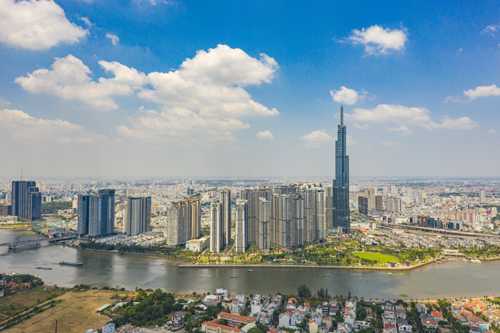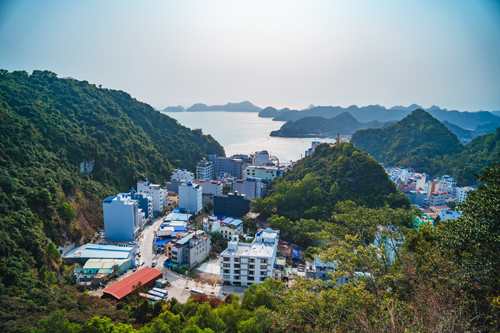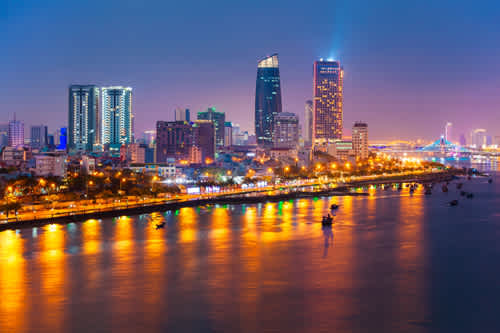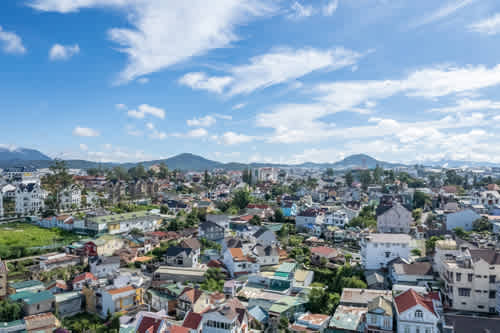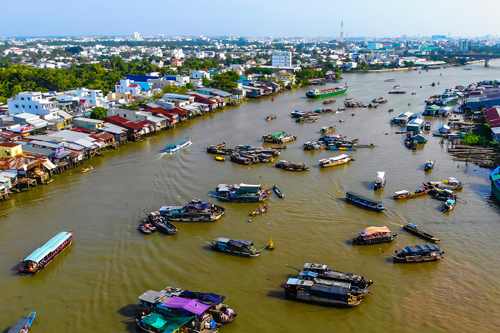About Vietnam
Vietnam, with its breathtaking beauty, offers an unforgettable journey through its rich history and vibrant present, captivating tourists with its stunning landscapes and vibrant culture.
From north to south, the country is home to so many stunning gems, that it is challenging to choose which part of Vietnam is the most beautiful. From the enchanting Halong Bay to charming towns and villages, mouthwatering cuisine to diverse traditions and warm hospitality, Vietnam is an enticing destination for travelers seeking unique and budget-friendly experiences.
When is the best time to visit Vietnam? It largely depends on what you’re looking to do on your vacation since the weather can vary significantly across the country’s regions throughout the year. Northern Vietnam is characterized by tall mountains and cooler winters, with some areas like Sapa in the far north, even experiencing snow. In the south, you’ll find the flat, tropical wetlands of the beautiful Mekong Delta, where the pleasant winter temperatures hover around the 70’s F.
July and August are generally hot and sticky – and the peak of the tourist season, especially at beach destinations. In the coastal resort areas, prices can soar by as much as 50% compared to off-season rates. It is not advisable to visit the northern regions in the summer months due to heavy rains, and even monsoons that can make treks inaccessible. To ensure a more comfortable and less crowded experience, it’s recommended to visit during the transition seasons, from April to June and September to November, in most parts of the country.
As you start researching and planning your trip, you may be wondering, “Which part of Vietnam should I visit?” To help you plan what to see in Vietnam, here are a few highlights to get you started:
Hanoi: Vietnam's capital city, located in the north, is a blend of old-world charm and modern attractions. Must-visit places include the Old Quarter, Ho Chi Minh Mausoleum, and the Temple of Literature. The Old Quarter, the heart of Hanoi, is famous for its narrow streets, bustling markets, and colonial-era architecture. Hoan Kiem Lake is a picturesque lake in the city center and home to Ngoc Son Temple and the famous Red Bridge. The Ho Chi Minh Mausoleum is the final resting place of Vietnam's founding father, Ho Chi Minh. The Temple of Literature is a historic Confucian temple and the site of Vietnam's first national university.
Hoa Lo Prison: Once known as the "Hanoi Hilton," this notorious prison held American prisoners of war during the Vietnam War. Today, it serves as the Vietnam War Museum, offering insights into the country's history.
Hue: Located in central Vietnam, Hue is a city rich in history and culture. It served as the imperial capital of Vietnam for centuries and is the central focal point of the Imperial City, which was declared a UNESCO World Heritage Site. This expansive complex is comprised of palaces, temples, and imposing gates. The "Perfume River" winding through the city allows for picturesque boat rides. Hue is also known as a center of traditional music, royal cuisine, and its historical pagodas. Hue’s rich heritage and tranquil ambiance make it a captivating destination for history enthusiasts and travelers seeking a glimpse into Vietnam's splendid royal past.
Hoi An: Hoi An, a coastal town in central Vietnam, is undoubtedly a cultural and architectural gem and one of Vietnam’s most beautiful areas. Its ancient town has been wonderfully preserved and is recognized as a UNESCO World Heritage Site. Hoi An offers a journey through time with its winding streets adorned with centuries-old buildings and lantern-lit alleys at night. Beyond its historical charm, Hoi An is famous for its stunning beaches.
Saigon (Ho Chi Minh City): Vietnam's bustling economic and cultural epicenter, Saigon boasts a skyline that seamlessly fuses modern skyscrapers with colonial-era architecture reflecting its rich history. Key attractions include the War Remnants Museum, the Cu Chi Tunnels used by the Viet Cong, and the Reunification Palace, each offering a window into Vietnam's history. The city’s vibrant street food culture and bustling markets provide culinary delights, and it is a cultural hub with numerous art galleries and theaters. Saigon's nightlife is lively, with many bars and clubs to explore.
Phong Nha-Ke Bang National Park: Nestled in the north-central region of Vietnam, this UNESCO World Heritage Site is renowned for its breathtaking karst landscapes and extensive cave systems. The park is a paradise for adventurers and nature enthusiasts, and it is home to the world's largest cave, Son Doong, along with other breathtaking caves like Paradise Cave. Beyond the caves, the park offers picturesque hiking trails, lush forests, and exciting river adventures.
Sapa: Located in northern Vietnam, the remote town of Sapa is one of the most beautiful parts of Vietnam, and it is renowned for its stunning rice terraces, diverse ethnic communities, and variety of hiking trails. Here, you'll encounter lively local markets and have the opportunity to interact with the friendly ethnic minority groups, all while taking in breathtaking mountain landscapes. It's a popular destination for travelers seeking an authentic experience as well as adventure, with its abundance of trekking opportunities. You can also take a short cable car ride up to the top of Fansipan Mountain, one of the highest mountains in Southeast Asia, for spectacular views of the valleys. While you’re in Sapa, be sure to sample the horsemeat stew, a slow-cooked local delicacy.
Mekong Delta: The Mekong Delta in southern Vietnam is another of the most beautiful parts of Vietnam. This picturesque region is characterized by complex waterways and lush landscapes. In the delta, you'll find bustling floating markets where locals buy and sell goods from small boats. Life here revolves around the river, and boat transportation is a way of life. Tourists can explore traditional villages, savor delicious cuisine, and experience a slower pace of life. The cultural diversity and natural beauty of the delta make it a charming destination for those seeking an authentic Vietnamese experience and tranquility.
Phu Quoc Island: The largest island in Vietnam, tropical Phu Quoc is located off the coast of Cambodia and is simply beautiful. Known for its stunning, sandy beaches, thick forests and jungle, hiking trails, and fish sauce production, it is an ideal destination to relax and enjoy water sports such as snorkeling and diving, and to explore the nearby An Thoi Archipelago. Duong Dong is the island’s largest town and it is home to day and night markets that sell fresh produce, fish, and local crafts.
Halong Bay: A UNESCO World Heritage Site located in northeastern Vietnam, Halong Bay is one of the country's most iconic attractions. The bay is characterized by its towering karst limestone formations that emerge from the emerald waters as well as its rainforests at the top of the islands. Explore it by boat or kayak and make sure to visit the famous caves within this picturesque bay. The area is also popular for scuba diving, trekking, and rock climbing.
Phong Nha-Ke Bang National Park: This area boasts astonishing karst rock formations and houses some of the largest cave systems in the world, stretching over approximately 120 kilometers (74.5 miles). This national park, one of Vietnam’s top adventure destinations, is a highlight for visitors to Vietnam, featuring underground rivers and mesmerizing pristine stalactite caves as well as hiking trails and kayaking.
Mui Ne Sand Dunes: Another one of Vietnam’s most beautiful destinations, Mui Ne is a fishing village on Vietnam’s southern coast. It is home to two huge sets of sand dunes – the Red and White Sand Dunes. The White Dunes are the area’s most popular attraction, and you can enjoy sandboarding, kiteboarding, ATV rides, and jeep tours across them. Mui Ne’s Red Dunes, a rusty red/brown color, are especially spectacular at sunset.
Cao Bang Province: Located in northeastern Vietnam, Cao Bang Province offers breathtaking views, including the wide-spanning Ban Gioc Waterfall. It's a home to diverse ethnic communities, and it highlights cultural treasures, providing a glimpse into Vietnam's heritage. Pac Bo Cave holds historical significance in Vietnam's history. Cao Bang is an exceptional destination for travelers seeking natural wonders, cultural diversity, and a deeper connection to Vietnam's heritage.
Ba Be Lake: Explore Vietnam's largest natural lake, situated in Ba Be National Park in northern Vietnam, offering opportunities for boating and hiking adventures. The national park is home to a varied assortment of fauna and flora.
Da Lat: A high-altitude city nestled at an elevation of around 1500 meters (4921 feet), Da Lat enjoys a cooler climate, earning it the nickname the "Eternal Spring City." It is surrounded by dense pine forests, and its main attraction is the picturesque Linh Phuoc Pagoda. At the Da Lat Flower Festival, usually held biennially, you can see a spectacular display of flowers and cultural events, which also gives the city its additional name, the "City of Flowers." The event features stunning flower exhibitions, flower-themed parades, cultural performances, and flower arrangement competitions.
Vietnamese cuisine is known worldwide. Meals generally feature a combination of five tastes: salty, bitter, sweet, sour, and spicy. Traditionally, Vietnamese cooking has used fresh ingredients, including vegetables and herbs, and very little dairy or oil. It is also low in sugar and typically gluten free, as most of the dishes are based on rice and not wheat.
Here is a primer about some of Vietnam’s most popular and distinctive dishes:
Pho: A fragrant noodle soup made with beef or chicken, often garnished with herbs, lime, and chili.
Banh Mi: A Vietnamese sandwich filled with various ingredients such as grilled meats, pickled vegetables, and herbs, all served in a French baguette.
Goi Cuon: Fresh spring rolls made from rice paper and filled with shrimp, herbs, pork, rice, and served with a dipping sauce.
Bun Cha: Grilled pork served with rice and a sweet and salty sauce, often accompanied by herbs and spring rolls.
Com Tam: Rice with grilled pork, fried egg, and fish sauce, a popular dish in southern Vietnam.
Bun Bo Hue: A spicy beef noodle soup originating from Hue, known for its rich and complex flavors.
Ca Kho To: Caramelized fish cooked in a clay pot, typically served with rice.
Bun Rieu: A tomato-based soup with crab and shrimp, served with rice noodles.
Pho Cuon: Fresh spring rolls filled with thinly sliced beef, herbs, and rice noodles, often served with peanut sauce.
Bun Thit Nuong: Grilled pork served with rice noodles, herbs, and a sweet and spicy sauce.
Xoi: Sticky rice, typically served as a side dish or dessert, with various toppings like mung beans and coconut.
Banh Xeo: Vietnamese crispy pancake filled with shrimp, pork, bean sprouts, and herbs.
Ca Phe: Strong Vietnamese coffee usually served with condensed milk and enjoyed hot or cold.
Vietnam is truly a gem in Southeast Asia and a land of boundless wonders. Along with its lush natural beauty, it offers a harmonious fusion of historical richness, vibrant culture, thrilling adventures, and delectable culinary experiences leaving travelers with memories of an outstanding and unforgettable trip.
Popular Itineraries
Traveled by thousands
Regions in Vietnam
Attractions in Vietnam
- Historic Center, Bac Ha
- Cai Rang Floating Market, Can Tho
- Historic Center, Can Tho
- Munirangsyaram Pagoda, Can Tho
- Cham Village, Chau Doc
- Floating Village, Chau Doc
- Historic Center, Chau Doc
- Bach Dang Avenue, Da Nang
- Cao Dai Temple, Da Nang
- Museum of Cham Sculpture, Da Nang
- Han Market, Da Nang
- Historic Center, Da Nang
- Huyen Khong Cave, Da Nang

